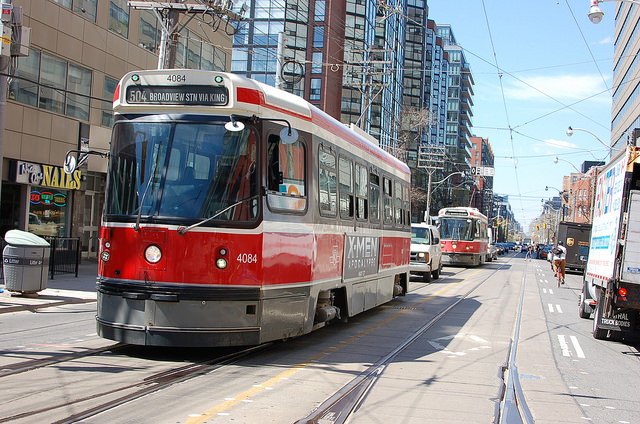Cyclists and urbanists rejoiced when the Bloor Street bike lane pilot project was approved 38-3 last week.
Despite this majority support, the two-day deliberation on approving the Bloor St. bike lanes revealed misunderstandings and concerns about implementing pilot projects that need to be addressed.
Jennifer Keesmaat, Toronto’s chief planner, has stated that it would be reasonable to expect a pilot project on King St. in spring 2017. A transportation pilot project is the best method to understand how King St. and neighbourhood roads will be affected by changes to transit and road space allocation, and how these changes can improve travel for the most people.
Some of the questions that came up around the Bloor St. pilot were about impacts to car traffic, service delivery like garbage collection, and the feared permanence of pilot projects.
Testing ideas
Pilot projects are the best way to modify or test planning ideas by collecting data, monitoring and evaluating performance or effectiveness at achieving objectives. They’re also a great way to make adjustments on-the-ground. Pilots are implemented at a lower cost than permanent projects and can be easily removed or modified.
Toronto is no stranger to pilot projects. In the past few years some notable projects have been the Richmond-Adelaide cycle track pilot, the Downtown Toronto Wayfinding pilot and Queens Quay bike lanes and greenspace.
The fact these all became permanent installations speaks to good planning, and the flexibility that comes with pilot projects to tweak and finesse the proposal. The Richmond-Adelaide cycle tracks were initially considered a failure when they first opened with just painted white lines. The city took in feedback, added bollards, and now the cycle track is a model for the city.
Even with the best traffic models and simulations we cannot know for sure how a planning idea will work until we test it on the ground. For example, the preliminary evaluation of the Richmond-Adelaide bike lane pilot showed that over half of drivers supported the presence of bike lanes – this is something that could not be modelled.
The Queens Quay bike lanes were tested over a 10-day period called “bike paradise” and only through this event could we understand the minimal traffic impacts and the huge demand for bike lanes on Queens Quay – the bike lanes have more than 600 cyclists per hour in summer months.
Understanding public reception
One of the benefits of pilot projects is they can be used to test human behaviour and public reception – modelling scenarios are more focused on understanding the impacts of a transit scenario on existing traffic conditions.
These models can’t accurately capture how people may change their travel behaviour, or how they feel about changes to design or operation. Pilot projects offer more opportunities for the public to voice their opinions and offer feedback to improve the final proposal.
In Stockholm, public opinion of congestion charging switched from being strongly opposed to dramatically positive after the implementation of a pilot project. In San Francisco, transit prioritization pilots helped to identify where traffic diversions were occurring and for signal adjustments to make drivers’ travel time more predictable.
We can see how other cities have dramatically improved travel experiences for cyclists, transit users and pedestrians through pilot projects.
New York City has become the poster child of pilot transportation projects. During the Bloomberg administration, the NYC Transportation Commissioner, Janette Sadik-Khan, took full advantage of temporary projects to test how the public would react to the reallocation of road space. Projects including transit priority lanes on major streets like 34th St., the pedestrianization of Times Square and installing bike lanes across the city were evaluated to gauge public use and how they affected transportation operations.
By embracing pilot projects, we can better understand the effectiveness of different transit solutions, and get our city moving. A proposed pilot project next year on King St. to prioritize transit should be seen as an opportunity to answer questions about use, public reaction and traffic impacts, rather than a threat to current road operations.







